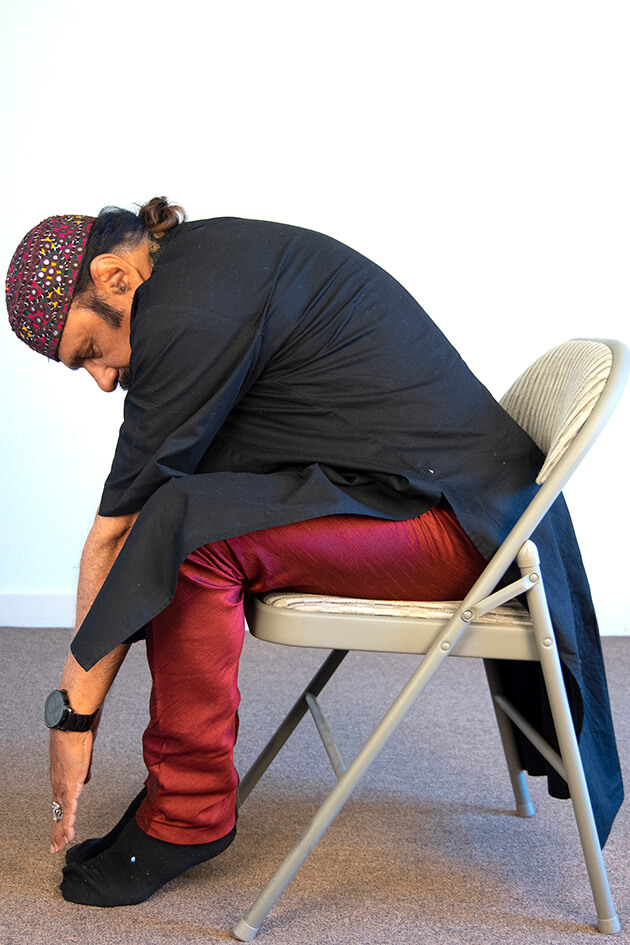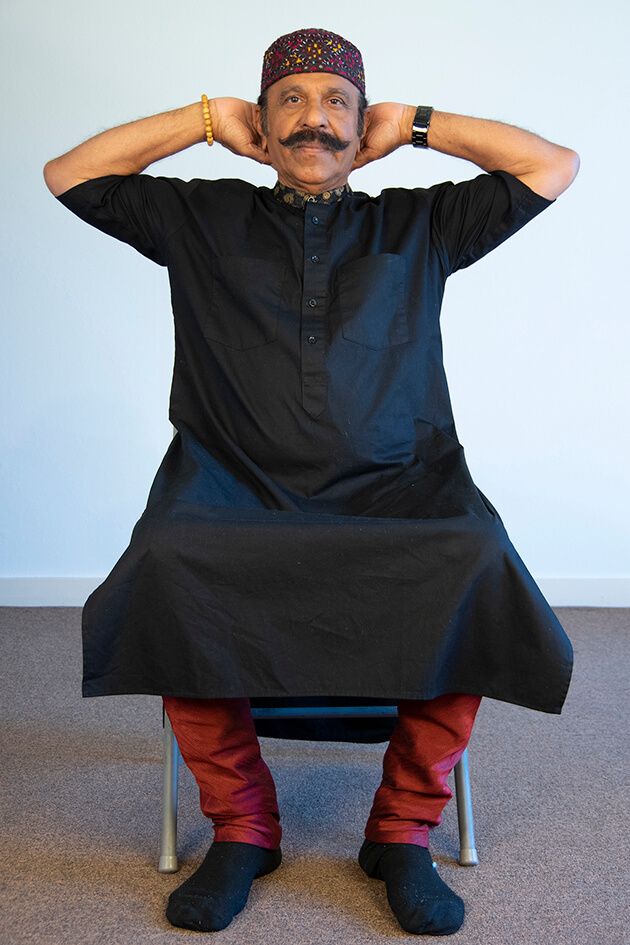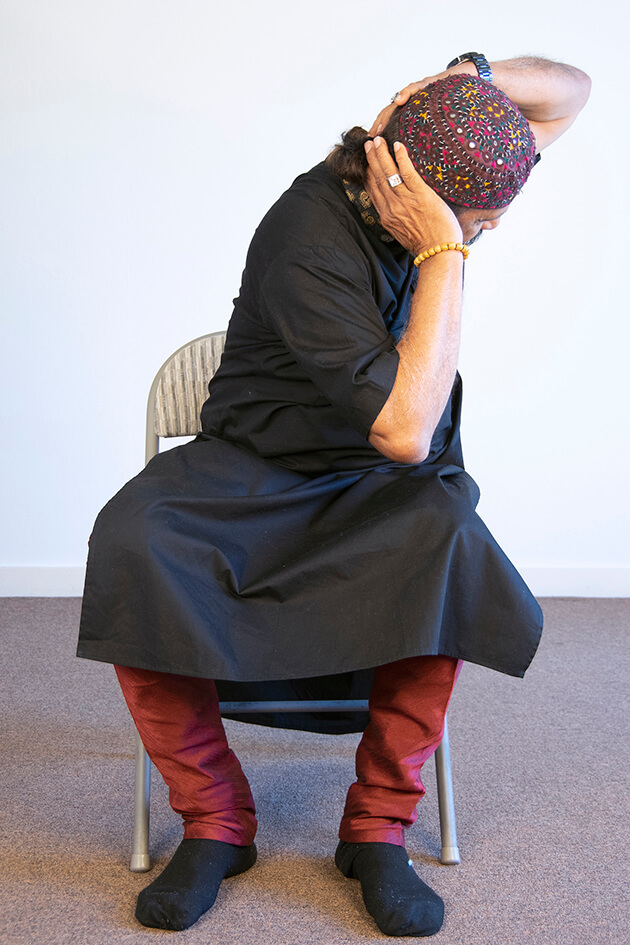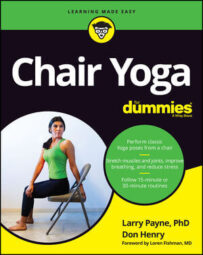Benefits of a chair yoga practice
Chair yoga lets you reap yoga’s most significant benefits:
- Better flexibility
- More overall strength
- Greater sense of balance
- Improved cardiovascular health
- Reduced stress and pain
- Better sleep
- Increased willpower
Even though yoga originated as an Eastern discipline, doctors and scientists in both the East and the West acknowledge the physical and mental health effects that adding yoga as one of your regular self-care routines can bring.
Who is chair yoga for?
By incorporating chair yoga, you can keep practicing yoga for a lifetime regardless of your age, physical condition, or lifestyle and schedule. Chair yoga is all about accessibility. And it may also be about choosing a style of yoga that most benefits you as a person at any point in time. Although chair yoga is really for anyone who wants to try it, here are a few groups who may find it particularly useful:
Seniors: The human body changes over time, but you can adapt chair yoga to exactly what your body needs, no matter your age.
Office workers: Being stuck at a desk often means you’re immobile for long periods. Chair yoga offers a potential solution without your having to leave, well, your chair.
Always check with your doctor before you start a fitness routine, even Chair Yoga, to see whether you should avoid any postures or movements.
Travelers: Staying in place on a long trip can wreak havoc on your body and mind. Consider simple chair yoga moves you can do right from your seat.
Expecting moms: Of course, your doctor should be your guide on what kind of fitness program is appropriate for your situation. Still, because chair yoga is so adaptable, it may be a perfect option.
People with limited mobility: If you have mobility issues (temporary or more permanent), you may well be able to adapt chair yoga to your needs.
The bottom line is that you don’t have to abandon Yoga just because you can’t or don’t want to get up and down off a mat. Chair Yoga is one way you can start to figure out how to make Yoga work for your particular needs and your particular body.
Choosing a chair for chair yoga
Unlike so many other activities, you only need a basic chair to do chair yoga. Still, it’s worth putting a little thought into your choice because your chair is going to be your greatest source of support. Following are some fundamental things to keep in mind when selecting your chair yoga chair:
- No arms: Even doing yoga while sitting in a chair is going to require that you move around a lot. When you’re lifting your own arms up and down and around, you don’t want the arms of your chair to get in the way and restrict your movement.
- No wheels: It’s not uncommon for certain types of chairs to be on wheels. For example, it can be very helpful to move around your desk or office in rolling chair. With chair yoga, however, wheels can be problematic. Sometimes, getting your body into certain positions or performing certain movements can be challenging enough without the added mission of making sure your chair doesn’t involuntarily roll around the room. Chances are you will want the chair to remain stationary, and sitting on wheels will only make that harder (and potentially unsafe).
- No swivel or rocking: The convenience of a swivel or the soothing quality of a rocking chair does have an important place in your life, just not in chair yoga. For all of the reasons discussed above, choose a chair that doesn’t move when you sit in it.
- The perfect height: For the sake of your back, choose a chair that will allow you to put both feet evenly on the floor. Because chairs, as well as people, vary in height, one particular chair isn’t necessarily right for everybody. It’s worth taking the time to make sure you’ve made the best possible choice. Of course, sitting up against the back of the chair may create some issues and you may need to slide forward in the seat. If that still doesn’t allow you to put your feet flat on the ground, consider putting something underneath them, like yoga blocks or even some books.
- Don’t forget about comfort! Even if a chair meets all the previously mentioned requirements, it still may be uncomfortable. You don’t want to be distracted by an unpleasant seat during your chair yoga practice. If your chair is going to be a true partner, definitely try to find something that’s comfy and perhaps even padded.
Chair yoga will travel
If immobility is detrimental to good health, then being stuck in a seat on a long trip may do some real damage by the time you finally reach your destination. Tight muscles are prime targets to be over-stretched and may easily fall victim to dragging your luggage from an overhead bin or from a moving carousel.
Luckily, chair yoga is ideal for tight spaces. And doing some simple chair yoga movements during your journey might be just what your body and your mind need. Of course, if you’re stuck in something like an airplane seat, you probably want to let your nearby fellow passengers know you’re about to do some stretches so that they don’t call for the flight attendant in a panic. They may even decide to join you!
Try the following exercises the next time you find yourself on a long ride or flight.
Forward bends for tight spaces
While doing a simple forward bend can help to reduce stress, it’s also a great way to stretch out your back, shoulders, and neck. Here’s how to do it:
- Inhale and sit tall in your seat with your feet on the floor.
- As you exhale, hinging from the hips, bend forward while at the same time raising your heels up, leaving your toes on the ground (see photo below).

A forward bend in chair yoga helps to stretch the back, shoulders, and neck, and reduce stress. - On your inhale, lower your heels back down as you sit up (hinging from the hips and returning to your starting position).
- Repeat this up and down sequence ten times, moving with your breath.
While allowing your head to drop is an effective way to relieve tension in your neck, it could also be bad for other types of conditions (like high blood pressure or retinopathy). Make sure that allowing your head to fall forward is a smart choice for you (you may need to consult your doctor if you have any concerns).
Knee to elbow
This stretch that you can do right in your seat brings some length and flexibility to your entire core, including your abdominals, back, and side waist.
- Inhale and sit tall in your chair with your hands behind your neck, as shown in the following photo.

The first step of the knee-to-elbow exercise in chair yoga - On an exhale, lean forward, bringing your right elbow toward your left knee (see the following photo).

The second step of the knee-to-elbow exercise in chair yoga - As you inhale, sit back up (into starting position).
- On an exhale, lean forward, bringing your left elbow toward your right knee.
- As you inhale, sit back up.
- Repeat Steps 2 through 5 five more times on each side, moving with your breath.

